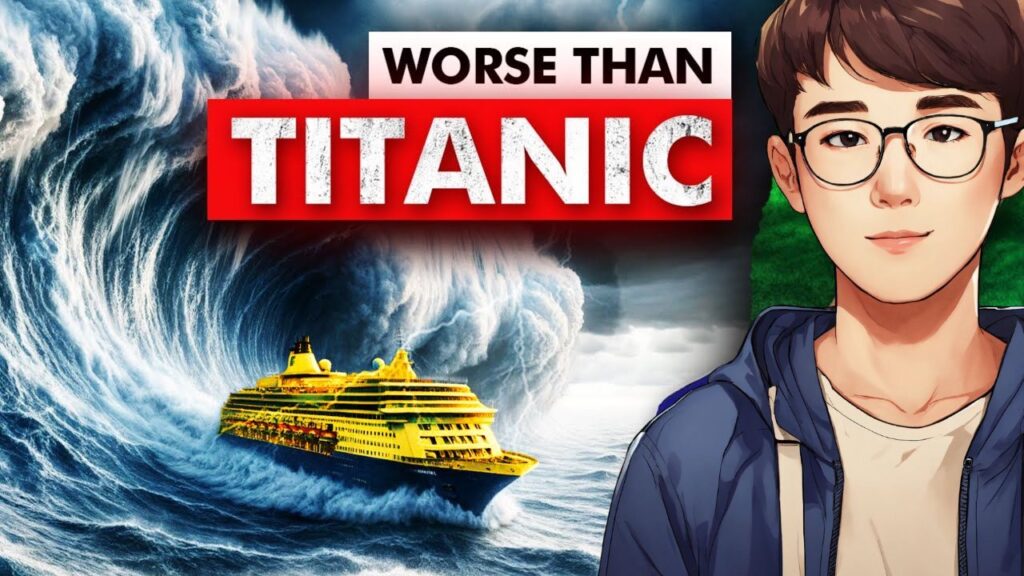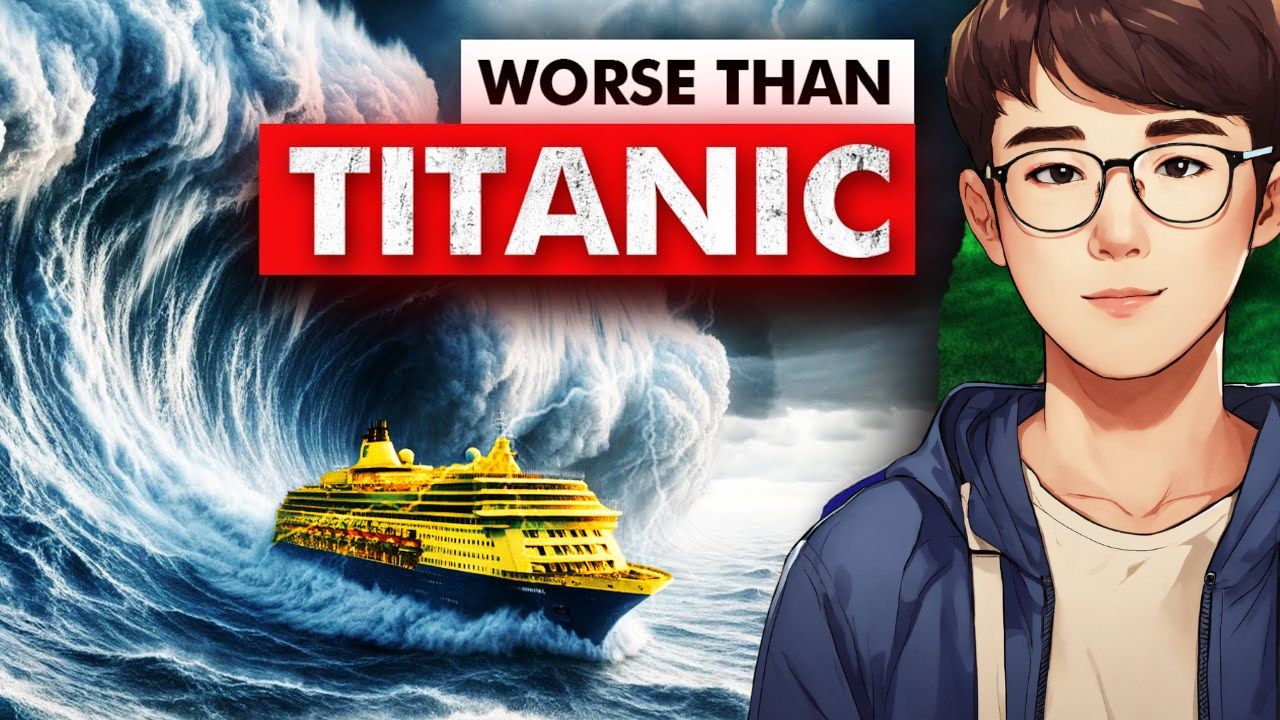The Concordia Cruise Mystery | What Went Wrong? | Titanic of 2012 | Dhruv Rathee
On 13th January 2012, at 7:15 PM, the world’s largest Italian cruise ship set sail for its 7-day European tour. This ship was named the Costa Concordia. It was so big that not only was it bigger than the Titanic, but it could seat an additional 2,000 passengers. That’s why 4,252 people were on board. If we talk about entertainment, this ship had everything—4 big swimming pools, 5 restaurants, 13 different bars, a casino, a basketball court, a huge fitness center with a gym, a sauna, a Turkish bath, and even an F1 racing simulator.

The first destination of this ship was Savona, a city in Italy, which was supposed to take about a day to reach. But only 2.5 hours after the ship departed, everyone heard a sudden piercing noise. After that, all the lights on the ship went off, and the ship started tilting towards one side. The time was 9:45 PM, a time when some people were sleeping in their rooms and some were eating at the dinner tables. Some people who were sleeping woke up and came out of their cabins to see what was happening. Meanwhile, the plates of the people sitting at the dinner table started sliding down the side of the table.
Passengers were told via intercom that there was an electrical failure on the ship. But the fact was that the engine of the ship had failed. The captain of the ship was hiding this fact from the people. After a while, the ship started tilting to the other side. By then, the passengers somewhat realized that this was not an ordinary electrical failure. People were worried that this was another incident similar to Titanic’s. Coincidentally, the Titanic accident happened exactly 100 years ago in 1912. And now, when this ship had an electrical failure, the famous Titanic theme song, “My Heart Will Go On,” was playing in the dining hall of this ship.
Slowly, the ship started tilting more. It tilted to the right side, and the lower rooms were being filled with water. By then, people had realized that the ship was going to sink. But why were the passengers not being informed properly? Why was the ship’s captain so quiet? This ship was operated by an Italian company called Costa Crociere. Initially, this company operated only cargo ships. But in 1948, they launched their Costa lines. Soon after, it became one of the biggest cruise ship companies in Europe. Later, in 2000, a company named Carnival Corporation bought it, so Costa Crociere became a subsidiary company of Carnival. In June 2006, they launched their first ship of the Concordia class, the Costa Concordia that we’re talking about today—the biggest Italian cruise ship of its time. The cost of making it was $570 million, ₹25 billion at that time.
That day, the captain of this ship was Francesco Schettino, an Italian man who had been working for this company since 2002. Remember his name because he plays an important role in our story. At 7:18 PM, this ship left for its first destination, Savona. And only two hours had passed when this ship deviated from its normal route. It was not a mistake. Captain Schettino wanted to take the ship by a particular island, Giglio Island in Italy. He wanted the people of the island to see the glittering ship in the dark of night. Whenever a ship passes near the land, it is called a sail-past or sail-by. Normally, such big ships sail at a distance of 7-8 km from the shore, well into the sea because the water needs to be deep enough for such a big ship to sail. But because of this sail-by, this ship was only 150 m away from the shore. Obviously, the water was not very deep. There can be big rocks or reefs under the ship at this close distance, which can hit the ship. On top of that, it was nighttime, and the ship was sailing quite fast.
Later, the report of the Italian Ministry of Infrastructure and Transport confirmed this. At night, the ship was sailing at an unsafe distance, very close to the shore. One question that will arise here is, why was the captain doing this? The thing is, Captain Schettino used to work under Senior Captain Mario Palombo, who was living on the Giglio Island. The night this ship was passing by this island, Captain Schettino called Mario and told him that since they would be passing by the island, they would sound a siren for him, as they wanted to give him a tribute.
To this, Mario said that he was not on the island, instead, he was in another Italian city. During this conversation, the call line got disconnected. This call was made at 9:40 PM, and a few minutes later came the scary sound that I mentioned at the beginning of the video. The thing everyone feared happened. This ship collided with the rocks in the water. This collision tore the hull of the Concordia ship. The ship’s sensitive part was injured by a 70-meter-long wound. The place where this impact happened was not even 100 meters away from the island. In the darkness of the night, this ship had reached so close to the island.
Water started flowing into the ship rapidly. 26-year-old Andrea Corollo, who was the third officer of the Concordia ship, was sleeping in his cabin when this incident happened. When he woke up and came out of his cabin, he saw that the water had already reached the hallway. He immediately ran to the engine room. When he reached there, he saw that the door could not be opened. Through the closed door, he could see that the generators and engines were completely submerged in water. At 9:52 PM, the chief engineer and the other officers of the engine room tried to start the emergency diesel generator. Unfortunately, they failed in this attempt. The chief engineer went to inform Captain Schettino about how bad the situation was. But the captain of the ship announced to the passengers that there was nothing to worry about, that it was a simple blackout.
Over the next few minutes, the ship was not standing still; rather, it was moving forward, away from the island. At around 10 PM, Captain Schettino felt that the ship should be turned around. He reasoned that if they sank, it would be more dangerous to be in the middle of the sea. It would be better to stay near the island. The ship took a U-turn and thus, instead of being upright, it started tilting to the other side. First, it was tilting to the left; now, it started tilting to the right. The ship’s crisis coordinator, Roberto Ferrarini, called Captain Schettino twice, at 10:05 PM and 10:07 PM. In the second call, Captain Schettino finally acknowledged that the ship had some problems. But had he admitted these problems sooner, it would have been better.
Turning away from the truth can be very dangerous, as you will see later in the story. And this applies to our lives too. Today, because of AI tools like ChatGPT, millions of jobs are in danger all over the world. The latest studies show that ChatGPT can give innovative ideas in a faster and better way than MBA students. It can easily pass law exams and business school exams. After hearing such news, you can either turn away from the truth or accept reality. Soon, those who will not be able to use these AI tools in their jobs and businesses will lag behind. And those who will use them from now on will get a huge advantage.
I use ChatGPT daily, and it has given me a huge boost in my productivity and efficiency. To help you take advantage of it from now on, I have made a 4.5-hour-long Master ChatGPT course entirely in Hindi. In this course, I have given practical and actionable advice on how you can use ChatGPT in your job, studies, and business to take your productivity and efficiency to the next level. Thousands of people have already taken this course, and you can see their reviews here on the screen. This is truly life-changing. If you haven’t joined the course yet, there is a special discount for the first 400 people—40% off if you use coupon code CON40. You can find the link to the course in the description below, or you can scan this QR code as well.
Now, if we get back to our topic, Captain Schettino did admit his mistake but followed it with another act of stupidity. He tried to cover up his mistakes. He claimed that the blackout caused the accident. He reversed the timeline. In reality, the accident caused the blackout. Meanwhile, some distressed passengers tried to call the local police. At 10:12 PM, the Italian coast guard called the ship’s captain, asking him what was happening on the ship and informing him that passengers of the ship were contacting them.
On the other hand, the captain said that nothing devastating had happened, that they simply had a blackout. He told them not to worry. When this was said, half an hour had already passed since the collision. Ten more minutes passed, and Captain Schettino finally changed his stance. After all, how long could he suppress the truth with lies? At 10:22 PM, Schettino told the radio operator to call and inform the coast guard that there had been a collision on the left side of the ship and that Concordia needed the help of tugboats, and that life jackets were handed out to the passengers, and everyone was safe.
Each minute was important here because the ship was gradually tilting more and more. Finally, at 10:33 PM, a general emergency alarm was raised, and the passengers were told to gather in the emergency assembly areas and wait for further instructions. Then 50 minutes after the collision, at 10:36 PM, the passengers were informed that the ship was going to sink and that they should leave the ship by lifeboats. Finally, at 10:42 PM, Captain Schettino ordered the lowering of the lifeboats. But even though the lifeboats had been lowered, the crew could not move the people to the lifeboats in an organized manner. Although the lifeboats had the capacity to carry 50 passengers each, only 10-15 people were getting on them.
There were more than 3,200 passengers on board, and every passenger wanted to be saved first. The people who were initially told that there was nothing to worry about now had to quickly board the lifeboats to save themselves. The ship was tilting more and more. Some lifeboats could not be lowered from the ship because it was tilting so much. Some passengers panicked and jumped into the sea. Captain Schettino himself sat in one of the lifeboats, and by 11:30 PM, he had left the ship. This man didn’t think even once about how his actions were going to affect so many people. The captain’s duty was to be the last person to leave the ship. Instead, Captain Schettino became the first person to leave. In such a scary environment, Captain Schettino’s decision to leave the ship was nothing short of criminal. At this time, he did not even inform the coast guard that he had left the ship.
As the night passed, the situation became more critical. The ship started tilting more and more. At 11:46 PM, the captain of another nearby ship called the coast guard to inform them about the sinking. The coast guard was surprised because Captain Schettino had still not informed them about it. After this, the coast guard themselves contacted Captain Schettino to ask him what was happening. At first, he refused to tell them that he had left the ship. Later, in another call, he admitted that he had left the ship. The coast guard was shocked and told him to get back on the ship immediately to save the passengers who were still on board. He was told that this was an order.
But, at 12:30 AM, when the first search and rescue teams reached the ship, Captain Schettino was seen standing on the shore, not trying to get back on the ship. Later, Captain Schettino would not follow up on the rescue teams. He got into his car and went home. By then, the ship had completely tilted to the right, and only the left side of the ship was above the water. There were still passengers trapped on the ship. If the captain had admitted his mistake earlier and ordered the evacuation sooner, many more people could have been saved. By this time, it was 1:30 AM, and it was very difficult to get the passengers out of the ship. A lot of passengers drowned while trying to get out. Many fell into the water from the tilted ship. The rescue team tried their best, but despite their best efforts, 32 people died in this tragedy. Their dead bodies were found in different parts of the ship and the water.
Later, the passengers of the Costa Concordia filed a case against the ship’s owner, the Carnival Corporation, for their captain’s wrongdoings. The ship’s crew admitted their mistake and compensated the passengers. But Captain Schettino refused to accept his mistake. He claimed that the accident happened because of the blackout. But as I told you before, this was not true. The blackout happened because of the accident. And even if we believe his words, the captain admitted that he left the ship in the middle of the disaster. The Italian government imposed a fine of 1 million Euros, around ₹90 million, on the Costa Concordia’s parent company, the Carnival Corporation. But the ship’s captain, Schettino, was charged with 32 counts of manslaughter and received a 16-year prison sentence.
This is what happened to the captain who was one of the first people to leave his ship. If he had accepted his mistake and taken action sooner, many more people could have been saved. It’s sad to say that after the ship tilted 90 degrees to one side, it had to be demolished, which cost the Carnival Corporation $1 billion, ₹40 billion in today’s terms. Captain Schettino’s act of taking the ship so close to the shore for his selfish desire was definitely criminal. But his act of abandoning his own ship while putting the lives of others in danger is one of the worst forms of selfishness. To this day, the families of the victims demand a life sentence for Schettino. What do you think, should Captain Schettino have been given a life sentence instead of a 16-year prison sentence? Do let me know in the comments below.






One Comment